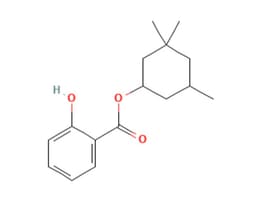Homosalate

Summary: A UVB filter under EU restriction due to systemic absorption and unresolved endocrine concerns.
Published on: 25/04/2025
Homosalate is a chemical UVB filter commonly used in sunscreen products, valued for its ability to absorb short-wavelength ultraviolet radiation, though it provides little protection against UVA rays and must be combined with other filters to achieve broad-spectrum coverage.
Regulatory Status and Safety Assessments
TThe European Commission's Scientific Committee on Consumer Safety (SCCS) originally considered homosalate safe at concentrations up to 10% in cosmetic products. However, in its revised 2021 opinion, the SCCS concluded that this level is no longer safe [1,2].
Current evidence on endocrine disruption potential include:
-
Research involving rat models has indicated that dermal exposure to homosalate during prenatal, lactation, and early postnatal periods can affect thyroid hormone levels, but concluded that homosalate does "not have endocrine disruptor effects on thyroid function and the pubertal development of female and male rats"[3];
-
Another study ssuggests that homosalate can exert cytotoxic (damaging to cells) and genotoxic (damaging to DNA) effects on rat thyroid cells at high concentrations, with some changes in thyroid-related gene activity observed in both rat and human thyroid cells. However, these effects occurred at doses much higher than typical consumer exposure. The authors recommend further research to fully understand the implications of homosalate exposure on thyroid function [4].
Homosalate is now considered safe only up to 7.34%, and only in face products such as creams and pump sprays. Importantly, the SCCS did not establish a safe use level for homosalate in full-body or other leave-on formulations, due to the higher systemic exposure associated with those products.
However, the SCCS also stated that the available evidence is inconclusive and does not allow for a definitive assessment of its endocrine-disrupting potential [2]: “The SCCS has regarded the currently available evidence for endocrine disrupting properties of homosalate as inconclusive, and at best equivocal. This applies to all of the available data derived from in silico modelling, in vitro tests and in vivo studies, when considered individually or taken together.”
References
-
Scientific Committee on Consumer Safety (SCCS). (2021). Scientific advice on the safety of Homosalate (CAS No 118-56-9, EC No 204-260-8) as a UV-filter in cosmetic products. SCCS/1638/21.
https://health.ec.europa.eu/system/files/2022-08/sccs_o_260.pdf -
Scientific Committee on Consumer Safety (SCCS). (2021). Final Opinion on Homosalate (CAS No 118-56-9, EC No 204-260-8). SCCS/1622/20.
https://health.ec.europa.eu/document/download/ddf0b68f-5c47-4ace-a87f-0a0e42ebd4a9_en?filename=sccs_o_244.pdf -
Erol, M., Çok, İ., Gayret, Ö. B., et al (2017). Evaluation of the endocrine-disrupting effects of homosalate (HMS) and 2-ethylhexyl 4-dimethylaminobenzoate (OD-PABA) in rat pups during the prenatal, lactation, and early postnatal periods. Toxicology and Industrial Health, 33(10), 775–791.
https://pubmed.ncbi.nlm.nih.gov/28879804/ -
Coperchini, F., Greco, A., Teliti, M., et al (2024). In vitro study of the UV-filter homosalate effects on rat and human thyroid cells. Environmental Pollution, 363, 125063.
https://pubmed.ncbi.nlm.nih.gov/39366447/